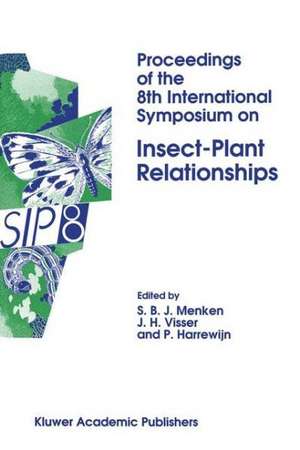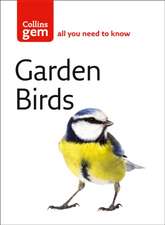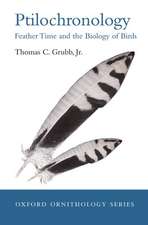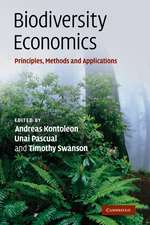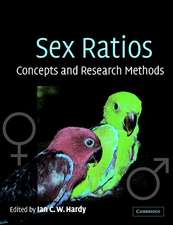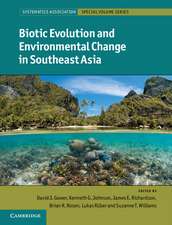Proceedings of the 8th International Symposium on Insect-Plant Relationships: ICMI Study Series, cartea 49
Editat de Steph B. J. Menken, J. H. Visser, Paul Harrewijnen Limba Engleză Hardback – 30 noi 1992
| Toate formatele și edițiile | Preț | Express |
|---|---|---|
| Paperback (1) | 396.40 lei 6-8 săpt. | |
| SPRINGER NETHERLANDS – 29 oct 2012 | 396.40 lei 6-8 săpt. | |
| Hardback (1) | 591.75 lei 6-8 săpt. | |
| Springer-Verlag GmbH – 30 noi 1992 | 591.75 lei 6-8 săpt. |
Preț: 591.75 lei
Preț vechi: 696.17 lei
-15% Nou
Puncte Express: 888
Preț estimativ în valută:
113.24€ • 121.08$ • 94.41£
113.24€ • 121.08$ • 94.41£
Carte tipărită la comandă
Livrare economică 17 aprilie-01 mai
Preluare comenzi: 021 569.72.76
Specificații
ISBN-13: 9780792320999
ISBN-10: 0792320999
Pagini: 440
Greutate: 0.79 kg
Editura: Springer-Verlag GmbH
Seria ICMI Study Series
ISBN-10: 0792320999
Pagini: 440
Greutate: 0.79 kg
Editura: Springer-Verlag GmbH
Seria ICMI Study Series
Cuprins
The importance of herbivore population density in multitrophic interactions in natural and agricultural ecosystems.- The evolution of plant resistance and correlated characters.- Habitat impact on insect communities of annual and perennial grasses.- Predispersal seed predation in the limitation of native thistle.- Preference, tree resistance, or chance: how to interpret differences in gall density among trees?.- Aggregation of aphid galls at ‘preferred’ sites within trees: do colonizers have a choice?.- Abundance and mortality of a specialist leaf miner in response to shading and fertilization of American holly.- Within-population variation in demography of a herbivorous lady beetle.- Continental-scale host plant use by a specialist insect herbivore: milkweeds, cardenolides and the monarch butterfly.- Resource partitioning of host plants by insects on a geographic scale.- Why do droughts often result in devastating insect epidemics? The African armyworm, Spodoptera exempta, as an example.- The impact of water and nutrient stress on oak leaf quality and gypsy moth performance.- Forest insect trends along an acidic deposition gradient in the central United States.- Birch foliage quality and population density of Eriocrania miners in a pollution-affected area.- Performance of Neodiprion sertifer on defoliated scots pine foliage.- Comparative studies of developmental biology, preference and feeding behavior of Monellia caryella on Juglandaceae native to North America.- Host-plant selection by the tropical butterfly Bicyclus anynana.- Interactions between host-plant information and climatic factors on diapause termination of two species of Bruchidae.- Assessing host-plant suitability in caterpillars: is the weight worth the wait?.- Size, feeding ecology and feedingbehaviour of newly hatched caterpillars.- Natural defence of pedunculate oak (Quercus robur) against the defoliating insect Euproctis chrysorrhoea.- Estimating costs and benefits of the pyrrolizidine alkaloids of Senecio jacobaea under natural conditions.- Induced chemical defence in Cynoglossum officinale.- Conversion of plant-derived pyrrolizidine alkaloids into insect alkaloids.- Phytoecdysteroids and insect-plant relationships in the Chenopodiaceae.- The non-nutrional relationship of Zonocerus (Orthoptera) to Chromolaena (Asteraceae).- Search behaviour: strategies and outcomes.- Response of the oilseed rape pests, Ceutorhynchus assimilis and Psylliodes chrysocephala, to a mixture of isothiocyanates.- Volatile plant metabolites involved in host-plant recognition by the cabbage seed weevil, Ceutorhynchus assimilis.- The olfactory and behavioural response of seed weevils, Ceutorhynchus assimilis, to oilseed rape volatiles.- Dispersive flight of the cabbage stem weevil.- Responses of the black bean aphid, Aphis fabae, to a non-host plant volatile in laboratory and field.- Aggregation in a flower bud-feeding weevil.- Electroantennogram responses of aphids to plant volatiles and alarm pheromone.- The role of host-plant odour and sex pheromones in mate recognition in the aphid Cryptomyzus.- Comparison of electroantennogram responses by females of the black swallowtail butterfly, Papilio polyxenes, to volatiles from two host-plant species.- Olfactory and visual cues in host-finding in the Burnet moth, Zygaena trifolii.- Specialization of receptor neurons to host odours in the pine weevil, Hylobius abietis.- Plant chemicals involved in honeybee-rapeseed relationships: behavioural, electrophysiological and chemical studies.- Volatiles from soybean foliage detected by means of a TCT-HRGC system: their possible role in insect-plant relationships.- Host-finding by Phoracantha semipunctata: host volatiles, electroantennogram recordings and baited field traps.- Chemical recognition of diverse hosts by Pieris rapae butterflies.- Role of nutrients found in the phylloplane, in the insect host-plant selection for oviposition.- Oviposition stimulant for the cabbage root fly: important new cabbage leaf surface compound and specific tarsal receptors.- Tarsal contact chemoreceptors of the cherry fruit fly, Rhagoletis cerasi: specificity, correlation with oviposition behaviour, and response to the synthetic pheromone.- Dietary mixing in generalist grasshoppers.- Semiochemicals isolated from the eggs of Ostrinia nubilalis as oviposition deterrent in three other moth species of different families.- Roles of chemosensory organs in food discrimination by larvae of the tobacco hornworm, Manduca sexta.- Sensory responses to the triterpenoid antifeedant toosendanin.- Insect antifeeding activity of some cardenolides, coumarins and 3-nitropropionates of glucose from Coronilla varia.- Seasonal variation in the importance of pollen volatiles on the reproductive biology of the sunflower moth.- Seasonal variation in plant chemistry and its effect on the feeding behaviour of phytophagous insects.- Associative learning in host-finding by female Pieris brassicae butterflies: relearning preferences.- Circadian stability of olfaction in Lobesia botrana.- Whitefly preference-performance relationships.- The role of salts in the feeding behaviour of locusts.- Computer-aided analysis of chemosensory data.- Analysis of sensory information using neural networks.- Azadirachtin treatment and host-plant selection.- The effects of azadirachtin on feeding by Myzus persicae.- Effects of the plant-derived antifeedant polygodial on aphid host selection behaviour.- The geometry of feeding: a new way of looking at insect nutrition.- A common chemical mechanism for insect-plant communication.- Genetics and the phylogeny of insect-plant interactions.- Host-race formation in a leaf-mining moth.- Host-race formation in the two-spotted spider mite (Tetranychus urticae).- Variation in the suitability of Barbarea vulgaris (Cruciferae) for the flea beetle Phyllotreta nemorum.- Plant secondary chemistry and the evolution of feeding specialization in insect herbivores: a different perspective.- Population genetical evidence for host-race formation in Yponomeuta padellus.- Latitudinal trends in oviposition preferences: ecological and genetic influences.- Role of any single herbivore species in the evolution of willows.- Potential of plant-derived genes in the genetic manipulation of crops for insect resistance.- The development of host-plant resistance to insect pests: outlook for the tropics.- Endogenous proteinase inhibitors induced in tobacco in response to herbivory: effects on the interpretation of insect resistance of transgenic tobacco plants.- Effect of induced resistance mechanisms in potato and tomato plants on the Colorado potato beetle.- Influence of phenolic compounds on the relationship between the cassava mealybug and its host plants.- Measurements of host plant-resistance in Chrysanthemum to Frankliniella occidentalis.- An automatic and accurate evaluation of thrips-damage. Image-Analysis: a new tool in breeding for resistance.- Susceptibility of Chrysanthemum cultivars to thrips (Frankliniella occidentalis) infestation and the role of some physical plant characters.- Effects of resistance in cucumber upon life-history components of Frankliniellaoccidentalis.- The impact of environmental conditions on survival of the leaf miner Liriomyza trifolii on Chrysanthemum cultivars.- Selection for resistance to insects causing ramification in Salix viminalis plantations.- Development of tolerance to plant allelochemicals by the Colorado potato beetle.- The use of restriction fragment length polymorphism analysis for identifying biotypes of the virus vector aphid Amphorophora idaei.- Biochemical adaptations of cereal aphids to host plants.- Criteria for host-plant acceptance by aphids.- Ultra structure and electrical recording of sieve element punctures by aphid stylets.- The behaviour of Nasonovia ribisnigri on resistant and susceptible lettuce lines.- Aphid pectinases, cell wall fragments, and biotype evolution.- Resistance of lettuce to the leaf aphid Macrosiphumeuphorbiae.- Expression of resistance in lettuce (Lactuca sativa) to Macrosiphum euphorbiae based on a monogenic factor.- Feeding behaviour of the aphid Sitobion avenae on resistant and susceptible wheat.- Russian wheat aphid and drought stresses in wheat: tritrophic interactions with Diaeretiella rapae and plant resistance.- Performance of pea aphid clones in relation to amino acid composition of phloem sap and artificial diets.- Effect of certain proteins on Acyrthosiphon pisum growth and development. Potential influence on aphid-plant interactions.- The influence of some non-protein amino acids on winter wheat resistance to the grain aphid.- Presence of hydroxamic acids in the honeydew of aphids feeding on wheat seedlings, and its significance for plant resistance and virus transmission.- Changes in phenolic compounds in cucumber leaves infested by the two-spotted spider mite (Tetranychus urticae).- Effects of spider mite infestation on biochemical characteristics of different gerbera cultivars.- Pleiotropic effects of genes in glossy Brassica oleracea resistant to Brevicoryne brassicae.- The role of brassica leaf surface chemicals in antixenotic resistance to Delia floralis.- Resistance to insects in glossy genetic lines of cole crops (Brassica oleracea).- Breeding potato for resistance to insect pests.- Modelling the impact of cotton fruiting phenology on pink bollworm population dynamics in Egypt.- The susceptibility of maize to Prostephanus truncatus infestation: development of a bioassay.- Microbial brokers of insect-plant interactions.- Microorganisms and kairomone production from Allium chemicals in a host-parasitoid relationship.- Plant resistance versus parasitoid attack in the evolution of the gall-forming fly Lipara lucens.- Genetic relationships between Oreina species with different defensive strategies.- Effect of host plants on growth and defence in two Phratora (Coleoptera: Chrysomelidae) species.- Effects of early season foliar damage on Phratora polaris (Chrysomelidae) and its defensive ability.- Simulated acid rain and the susceptibility of the European pine sawfly (Neodiprion sertifer) larvae to nuclear polyhedrosis virus.- Identification of cereal aphid parasitoids by epicuticular lipid analysis.- Do plants reduce herbivore attack by providing pollen?.- How cassava plants enhance the efficacy of their phytoseiid bodyguards.- Infochemicals that mediate plant-carnivore communication systemically induced by herbivory.- Mite herbivory causes better protection in downwind uninfested plants.- Parasitoids foraging for leaf damage: do they see beyond the end of their antennae?.- Do plants manipulate the third trophic level?.- The role of plant cues in mediating host and food searching behavior of parasitoids:importance to biological control.- Systemic releases of volatiles by herbivore-damaged plants: what possible functions?.- Natural enemy impact varies with host plant genotype.- Chemistry of insect-plant interactions.- Insect behaviour.- Variability in insect-plant interactions.- Specialization in herbivorous insects.- Impressions of the symposium, thoughts for the future.- List of Participants.- Index of Authors.- General Index.
